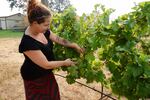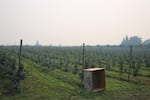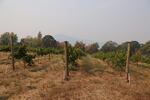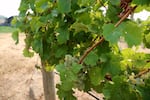
Jocelyn Bentley-Prestwich, the marketing manager at Cathedral Ridge Winery, tests the ripeness of the vineyard's Riesling grapes.
Molly Solomon / OPB
On a clear day, Jocelyn Bentley-Prestwich can see Mount Adams from the vineyard where she works in Hood River. But lately, she’s had difficulty seeing to the end of her property line.
With the Eagle Creek Fire burning along the Columbia River Gorge, Hood River has been cloaked in heavy smoke for more than a week.
“The first couple of days, you couldn’t even see past those trees,” Bentley-Prestwich says as she points a couple yards away to the trees that line the perimeter. She’s the marketing manager of the seven-acre Cathedral Ridge Winery.

Smoky conditions from nearby wildfires have led some farmworkers to go home early in Hood River, Oregon.
Conrad Wilson / OPB
“We’re one of the larger-trafficked wineries in the area because we have such sign visibility from the highway,” she says.
But with Interstate 84 closed because of the fire, business has slowed to a crawl. Normally, on a warm September day, the tasting room would be packed, with close to 150 people stopping by.
“Right now, we’re not even seeing half of that,” says Bentley-Prestwich. “It’s pretty shocking.”
But it’s not just the hit to tourism that’s concerning.
Outside on the vineyard, Bentley-Prestwich shows off a row of Riesling grapes ripening on the vine. She pops one into her mouth, testing it for ripeness.
“Still a little tart, but they’re good,” she says, estimating another week until the grapes are ready for harvest.
The taste is an important factor. All the smoke and ash hanging in the air could easily transfer to the grapes, potentially changing the quality of the wine.
“When you have this much smoke in the air, you have complete climate change: it’s cooler, the atmosphere is different,” Bentley-Prestwich explains. “If it’s hazardous for us to breathe, you can only imagine what’s happening when it falls on the leaves and the grapes.”
Bentley-Prestwich says the effects of wildfire smoke are being debated in wine circles across the West Coast. Several roundtable discussions on the subject have been held with local wineries, including one organized by the Oregon Wine Board in early September.
“This is a huge thing for the wine industry because Oregon and Washington have these major wine industries. This is something everybody is taking very seriously,” she adds.

In the Mid-Columbia area, there are 440 growers and 20 shippers of tree fruit. Many along the Columbia River Gorge are battling smoky conditions from the Eagle Creek Fire.
Molly Solomon / OPB
Behind California, Oregon and Washington have the highest number of wineries in the country. Together, the industry brings in more than $5 billion a year to the Pacific Northwest. But with wildfires becoming all too common in the region, some growers are turning to science for help.
“There’s concern all up and down the West Coast with the fire intensity that we’re seeing,” says Thomas Henick-Kling, the Director of the Viticulture and Enology department at Washington State University.
Henick-Kling’s department is the only one in the country leading research on what happens when grapes are exposed to smoke for extended periods of time. He says more often, they develop a certain taste or smell called smoke taint.
“These wine taints are described as sometimes campfire, but also ashtray. Those aromas, of course, are not very attractive in a wine,” he explains.
Several treatments to remove smoke taint have been investigated, but none has proven to be entirely effective.
“There is no fix for smoke taint and it is unpredictable due to the fact that it evolves during the aging of the wine,” says Anita Oberholster, a chemist with the Department of Viticulture and Enology at UC Davis.
Oberholster says just 30 minutes of exposure to heavy smoke can impart smoke taint to grapes at certain times of the ripening cycle.

Farmers in the Pacific Northwest say they're not concerned about the smoke impacting their fruit, but they are worried about the safety of their workers.
Conrad Wilson / OPB
But vineyards aren’t the only agriculture producers concerned about the smoke. The harsh working environment has also given farmers pause.
“There’s really no problems with the smoke regarding the fruit. But we are concerned about the workers,” says Mike Doke, the Executive Director of the Columbia Gorge Fruit Growers, which represents 440 growers and 20 shippers of tree fruit in the Mid-Columbia area.
Orchards near the wildfires are providing masks and have been letting farmworkers go home early to minimize their exposure. Doke says if the smoke continues, growers could run into problems if farmworkers are not able to stay in the fields as long. He adds that it’s also rough financially for the workers, who rely on more hours during peak harvest season.
“When it’s harvest time, they work six to seven days a week,” Doke says. “This is the time when people make their living.”

Smoke from the Eagle Creek Fire is seen from the seven-acre vineyard Cathedral Ridge Winery in Hood River, Oregon.
Molly Solomon / OPB
Farther south, some growers have been dealing with smoky conditions for more than a month. Evan Kruse is the owner of Kruse Farms in Roseburg, Oregon. His family has sold fruits and vegetables there since 1923.
“I remember growing up a few times that it was smoky in the area. But this was really the first time that it was oppressive,” says Kruse. “And when it was at its worst, I couldn’t see across some of our fields.”
Kruse says he suffered various symptoms from working in the smoke. Sometimes he came home short of breath, his head pounding from migraines and dizzy spells.
On those bad smoke days, the farm wasn’t able to set up for outdoor markets. And even when they did, few customers came by.
“If we have a slow day, a slow weekend, we can’t make that up,” he explains. “That’s opportunity lost for us.”
For Michael Guebert, it’s been more than a slow weekend.

Winemakers in the Pacific Northwest are concerned about the smoke from wildfires impacting the taste of their grapes, and ultimately their wine.
Molly Solomon / OPB
The owner of Terra Farma, a pasture-raised livestock farm in Corbett, Oregon, had to close up shop and relocate. His home and ranch is in the Level 2 evacuation zone for the Eagle Creek Fire. With help from Sound Equine Options, he spent last Monday moving his three dairy cows and 20 goats after the evacuation level was raised.
“I feel like we’re safe for now,” Guebert says. “But I didn’t know if we’d have a home or a farm to come back to.”
Guebert says he can’t run a clean operation off site and estimates the closure is costing him $1,000 a week in lost income.
“If it continues, it will start to add up,” he says.
At this point, Guebert says the best thing he and other farmers can hope for is rain.